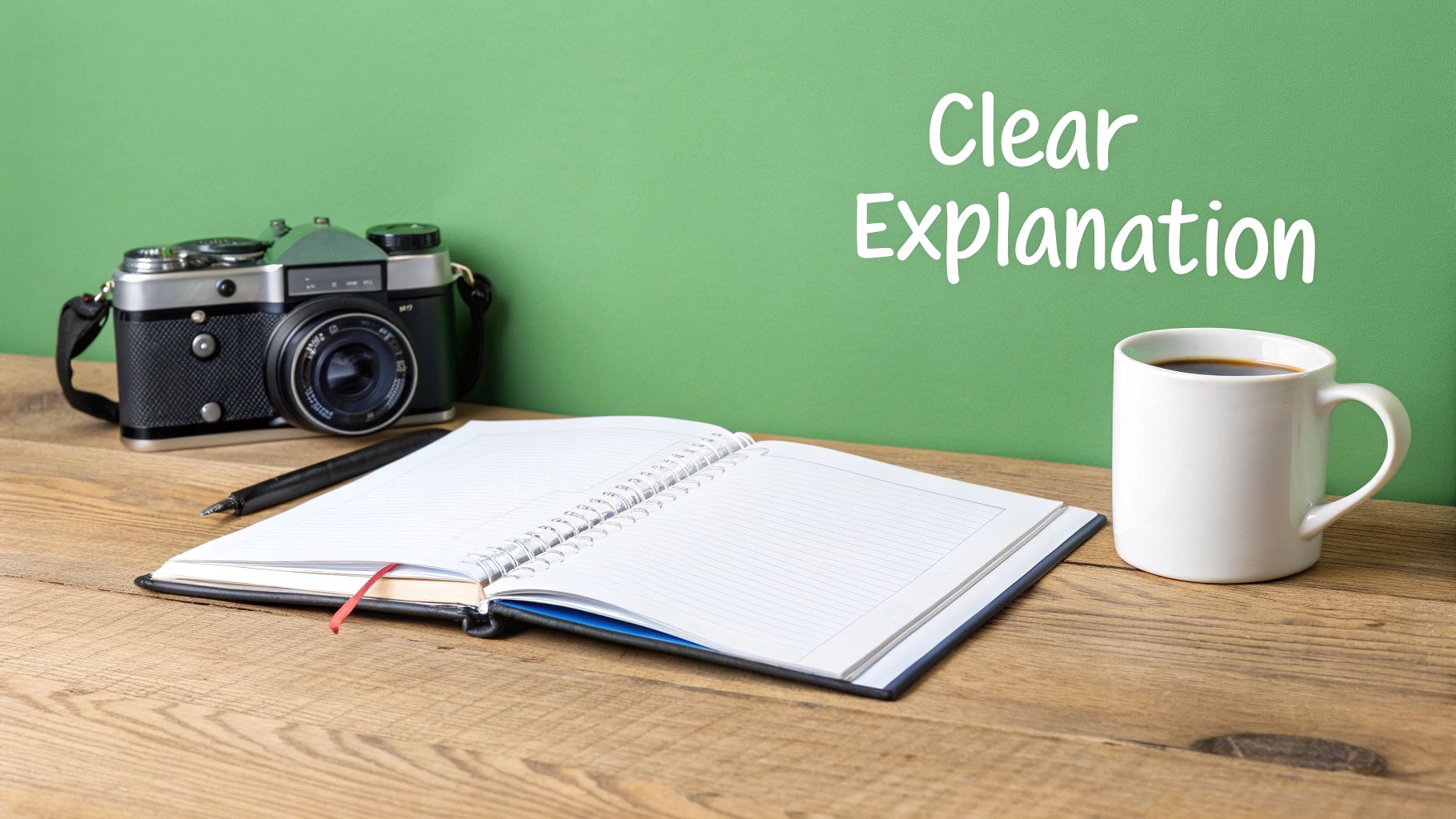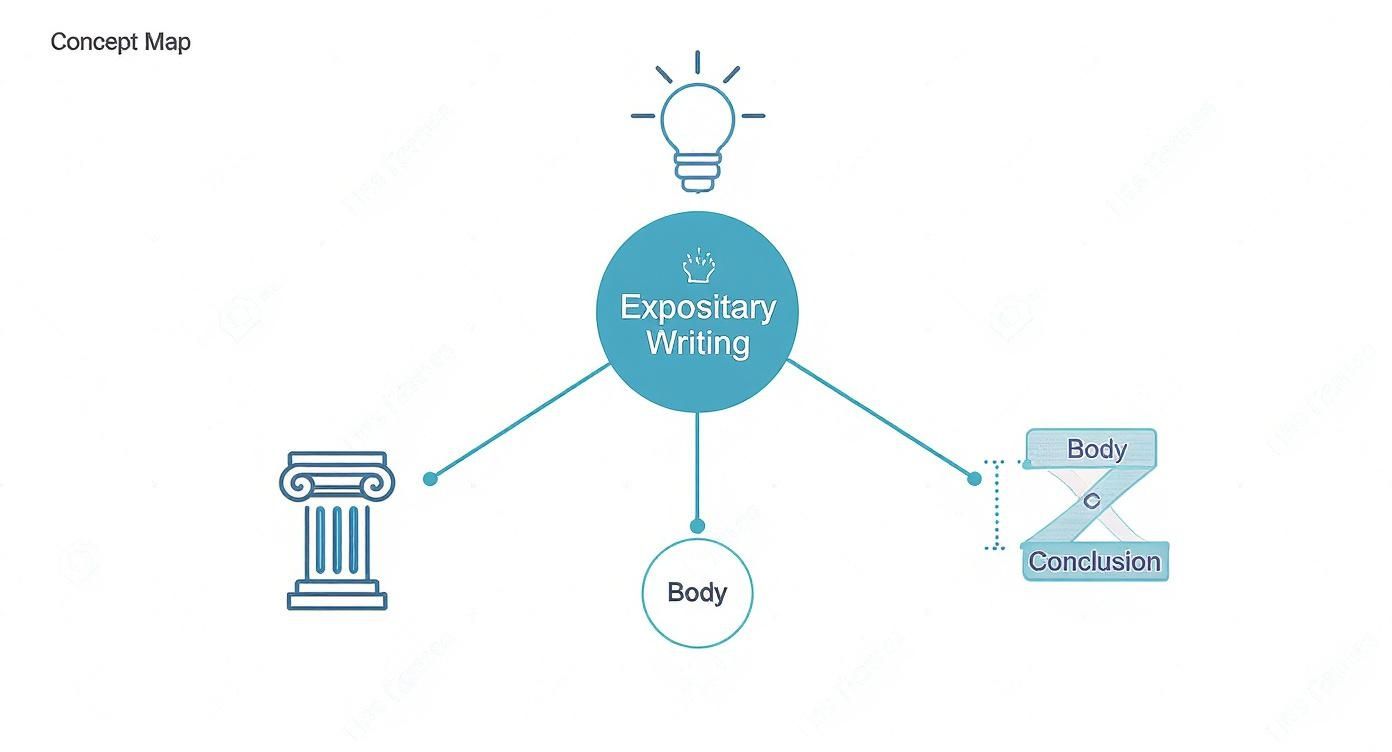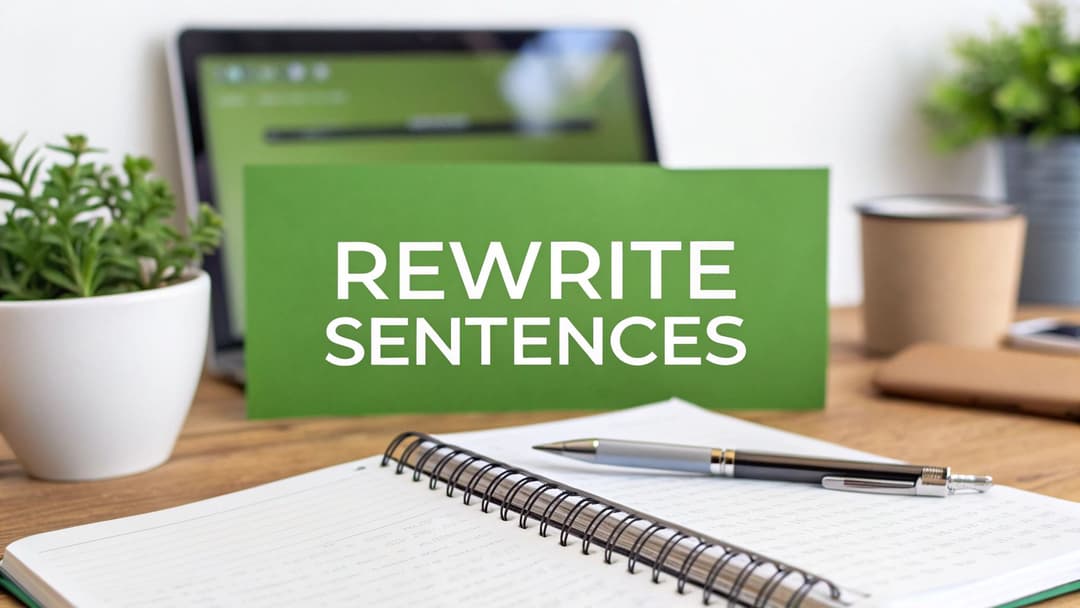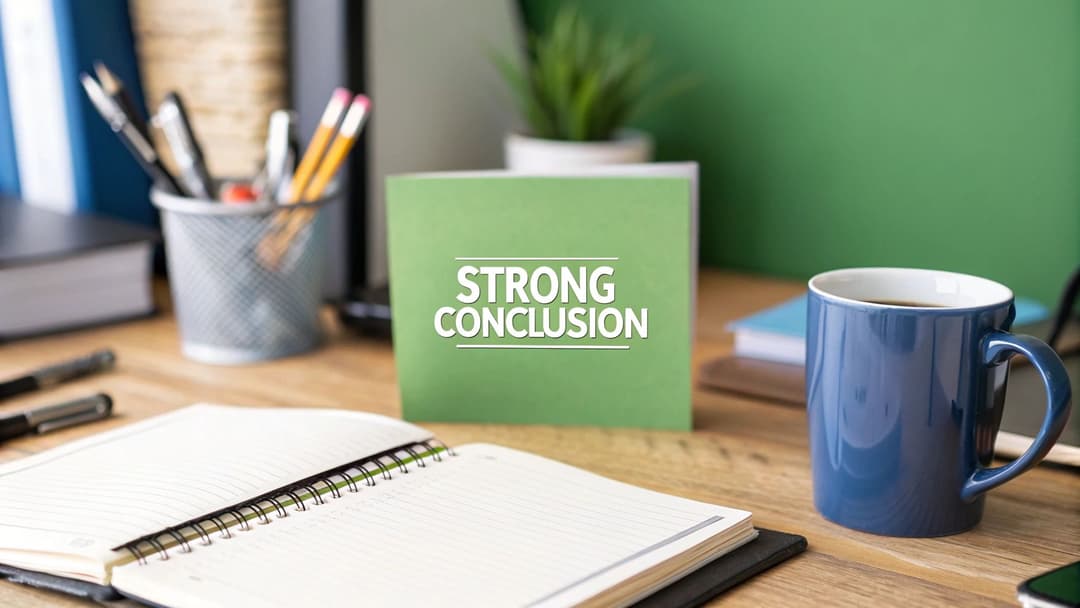
What Is Expository Writing and How to Master It
November 4, 2025
Expository writing is all about one thing: clear, straightforward explanation. Its entire purpose is to inform, define, or clarify a topic using facts, logic, and a healthy dose of organization.
Think of it as the ultimate guide. It’s not trying to sell you an idea or tell you a gripping story. It’s simply there to help you understand something, much like a teacher explaining a concept or a news reporter breaking down an event. The goal is pure, unadulterated clarity.
Unpacking the Core of Expository Writing

Imagine you're watching a nature documentary. The narrator doesn't try to convince you that lions are "better" than zebras. Instead, they present facts about their behaviors, habitats, and roles in the ecosystem. That’s expository writing in a nutshell. It acts as a neutral messenger, focused solely on delivering accurate information.
This style is the bedrock of how we learn and share knowledge. It deliberately sidesteps emotional appeals and persuasive tricks. Its power comes from its structure, clarity, and commitment to the facts.
What Sets It Apart
Unlike other kinds of writing, expository text doesn't ask you to feel a certain way or do a specific thing. It just asks you to understand.
- It’s not persuasive: The goal isn’t to argue a point, but to explain a reality.
- It’s not narrative: It doesn't tell a personal story with characters and a plot.
- It’s not descriptive: While it can use descriptive details, its main purpose is to inform, not just to paint a picture. For a closer look, you can explore our guide on what is descriptive writing.
The backbone of expository writing is objectivity. The author steps aside, allowing the facts, statistics, and logical progression of ideas to lead the reader to a clear understanding of the subject matter.
This commitment to fact-based communication is why you see it everywhere in educational and professional settings. In fact, a 2019 survey reported that over 70% of writing assignments in U.S. middle and high schools are expository. That really highlights how critical it is for developing clear thinking and communication skills. You can dig into those findings over at self-publishingschool.com.
Expository Writing at a Glance
To make the concept even clearer, here’s a quick breakdown of its core characteristics. This table sums up its purpose, tone, and where you're most likely to run into it.
| Characteristic | Description | Example Usage |
|---|---|---|
| Primary Purpose | To inform, explain, define, or clarify a topic. | Textbooks, "how-to" articles, recipes. |
| Tone | Objective, neutral, and fact-based. Avoids personal bias. | News reports, scientific papers, research summaries. |
| Structure | Logical and organized, often with a clear thesis statement. | Business reports, instruction manuals, encyclopedia entries. |
Ultimately, expository writing is the foundation for sharing knowledge effectively, whether you're learning a new skill or explaining a complex process to someone else.
Building the Framework for Clear Explanations
Think of effective expository writing like building a house. You wouldn't just dump a pile of bricks and hope for the best, right? You need a solid blueprint. That's exactly what a strong structure does for your writing—it gives your ideas a foundation, support, and a roof to keep everything together.
Your goal isn't just to throw facts at the reader. It's to assemble them so logically that navigating your thoughts feels effortless, from the first sentence to the last. Without that intentional framework, even the most fascinating information can fall flat.
The Foundational Introduction
Your intro is the concrete slab everything else is built on. It has two main jobs: grab the reader's attention and point them in the right direction. This is where you lay down your thesis statement—a single, sharp sentence that declares the main point you're going to prove or explain.
A killer thesis is the most critical part of your blueprint. It tells your reader, "Here's what this is about, and here's where we're going." For instance, instead of being vague, you could say, "The shift to renewable energy is non-negotiable for cutting carbon emissions and securing our economic future." Now that's a clear destination.
The Structural Beams of the Body
The body paragraphs are the load-bearing walls of your argument. Each one needs to support a single, distinct idea that links directly back to your thesis. Think of every paragraph as a pillar holding up your main point, reinforced with solid proof.
This is where you build trust and make your points stick. You back up your ideas with things like:
- Facts and Statistics: Hard data gives your claims undeniable weight.
- Expert Opinions: Quoting people who know their stuff adds instant credibility.
- Illustrative Examples: Real-world stories make abstract ideas click.
A great way to make sure every paragraph is pulling its weight is to use effective outlining techniques for structuring your ideas. It’s the best way to ensure your points flow together into one cohesive, powerful argument.
The organized structure of expository writing is its greatest strength. It guides the reader through a logical progression of ideas, making complex information digestible and preventing any confusion along the way.
There's a reason the classic five-paragraph essay is drilled into us—it works. It’s used in roughly 85% of middle and high school writing assignments because it masters this very structure. In fact, studies show that students who get this framework down can see their standardized writing scores jump by 15-20%. More importantly, that kind of clarity can boost a reader's information retention by up to 35%. You can check out more on these educational insights on study.com.
The Capstone Conclusion
Finally, your conclusion puts the roof on the whole structure. It’s your chance to tie everything together neatly. You’ll briefly recap your main points and restate your thesis, but in a fresh way—no simple copy-pasting allowed.
A strong conclusion leaves your reader with a sense of closure and one last, memorable thought to chew on. Before you call it done, a final polish is essential; our guide on what is content editing can walk you through that process. A well-built conclusion ensures your reader walks away with a complete and lasting understanding of your topic.
Exploring the Six Types of Expository Writing
Expository writing isn’t just one single style. Think of it more like a toolkit, with different tools for different jobs. Each type has a specific goal, whether you’re trying to describe something, explain a process, or break down a complex problem.
Understanding these variations helps you pick the perfect approach to get your point across with total clarity. There are six main forms, and knowing how they work is the first step to mastering them in your own writing.
Descriptive and Process Writing
First up is descriptive writing. This style focuses on painting a vivid, fact-based picture of a person, place, or thing. But unlike creative writing, it stays objective. It uses sensory details to inform, not to stir up emotion. A perfect example is a technical manual describing the parts of a machine or an encyclopedia entry on a specific animal.
Next, there's process writing, which you probably know as "how-to" writing. Its only job is to explain the steps needed to complete a task in a clear, sequential order. From recipes and assembly instructions to software tutorials, process writing turns complexity into simple, actionable steps. You know it’s successful if your reader can follow the instructions perfectly.
Compare and Contrast and Cause and Effect
The third style is compare and contrast. This one is all about examining the similarities and differences between two or more things. It’s incredibly useful for making informed decisions—think of a consumer report comparing two smartphones or a business analysis weighing different marketing strategies. The goal is to lay out the key distinctions so the reader gets a balanced view.
Fourth on the list is cause and effect writing. This type explores the relationship between an event (the cause) and what happens because of it (the effects). It’s the backbone of historical analysis, scientific reports, and news articles that try to answer the question, "So, why did this happen?" This form helps readers see the connections between actions and their consequences.
This concept map shows how the standard structure—introduction, body, and conclusion—holds all these expository types together.
As you can see, a strong thesis in the intro really does guide the entire piece, with the body paragraphs providing the structured support.
Problem and Solution and Definition or Classification
Problem and solution writing does exactly what it says on the tin. It clearly lays out a specific problem and then proposes one or more workable solutions, backing them up with solid evidence. You’ll find this style all over policy papers, business proposals, and editorials that aim to tackle a tough issue with practical answers.
Finally, we have definition or classification writing. This form is dedicated to explaining a concept, term, or idea in serious detail. It usually goes way beyond a simple dictionary definition by providing examples and placing the subject within a broader context. A textbook chapter explaining "photosynthesis" or an article defining a tricky legal term are prime examples.
Each type of expository writing gives you a distinct framework for organizing information. The structure isn't just a suggestion—it's the key to making your explanation logical, coherent, and easy for the reader to absorb.
To help you see how these styles stack up against each other, here’s a quick side-by-side look.
Comparing the Types of Expository Writing
This table breaks down the six main styles, showing you what each one is trying to achieve and how it's typically structured.
| Type | Primary Goal | Common Structure |
|---|---|---|
| Descriptive | To provide a detailed, objective picture of a subject. | Spatial or topical order, focusing on key attributes. |
| Process | To explain how to do something step-by-step. | Sequential order, following a chronological process. |
| Compare/Contrast | To highlight similarities and differences. | Point-by-point or subject-by-subject comparison. |
| Cause/Effect | To explain the reasons for and results of an event. | Identifies a cause, then details its multiple effects. |
| Problem/Solution | To identify an issue and propose a resolution. | Outlines the problem, then presents and supports a solution. |
| Definition | To explain the meaning of a complex term or idea. | Provides a definition, examples, and classification. |
Having these different structures in your back pocket makes it much easier to choose the right one for the information you need to share.
Seeing Expository Writing in the Real World
Theory is great, but to really get expository writing, you have to see it in the wild. This style is everywhere, hiding in plain sight. Once you start looking, you’ll find it in places you use every single day. Let's break down a few common examples to see how it works.
We’ll start with one of the most common places you’ll find this type of writing on the internet.
Example 1: Definition in an Encyclopedia
When you need a straight, no-nonsense explanation of something, where do you turn? For most of us, it’s Wikipedia—a massive, living library built entirely on expository writing.
The whole point of Wikipedia is to provide neutral, factual summaries on pretty much any topic you can think of. It's the definition style in its purest form.
Take a look at this snippet from the "Photosynthesis" entry:
"Photosynthesis is a process used by plants and other organisms to convert light energy into chemical energy, through a cellular process that is later released to fuel the organism's activities. This chemical energy is stored in carbohydrate molecules, such as sugars and starches, which are synthesized from carbon dioxide and water."
This is a textbook example. The tone is completely objective, with zero personal opinion. It presents a clear main idea (what photosynthesis is) and backs it up with supporting facts (what it does and what it creates). Simple and to the point.
Example 2: Cause and Effect in a News Report
News reports rely heavily on the cause and effect structure to make sense of complex events for the public. A good reporter connects the dots, showing how one action led to a specific consequence, which helps us all understand the bigger picture.
Think about a news article covering a recent wildfire:
"A prolonged drought throughout the summer created dangerously dry conditions across the region (the cause). When lightning from a severe thunderstorm struck a parched forest on Tuesday, the fire ignited almost instantly and spread rapidly due to high winds (the effects)."
This breaks down the chain of events perfectly.
- Main Idea: The wildfire happened because of drought and a lightning strike.
- Logical Flow: It walks you through what happened in order, linking the initial condition (drought) to the trigger (lightning) and the final result (the fire spreading).
- Objective Tone: The reporter isn't trying to stir up emotions or place blame. They’re just explaining how it all went down, sticking strictly to the facts.
Example 3: Compare and Contrast in a Consumer Review
Finally, let's look at something we've all read: a consumer report comparing two popular smartphones. This kind of writing is designed to help you make a smart decision by laying out the pros and cons of your options side-by-side.
"The iPhone 15 Pro and the Samsung Galaxy S24 Ultra both feature impressive camera systems and high-refresh-rate displays. However, the iPhone excels in video recording quality, offering smoother stabilization. In contrast, the Galaxy S24 Ultra provides greater versatility with its 10x optical zoom lens, a feature the iPhone lacks."
This is a classic compare and contrast. The writer's point is that while both phones are fantastic, they shine in different areas. By providing specific, factual evidence (video quality vs. zoom), it gives the reader the clear information they need to decide which phone is a better fit for them.
A Practical Guide to Crafting Your Own Piece
Now that you’ve seen expository writing in the wild, it’s time to roll up your sleeves and create your own. Building a clear, informative piece isn't about magic; it's a systematic process. If you follow a structured approach, you can take a complex topic and explain it in a way that just clicks for your reader.

Think of these steps as your toolkit for building fact-driven content with confidence, from the first spark of an idea to the final polished draft.
Step 1: Choose and Narrow Your Topic
Every great piece starts with a single subject. The trick is to start broad, then zoom in on something you can actually cover well. A topic like "World History" is a recipe for disaster—it's just too big. But "The Impact of the Printing Press on Renaissance Europe"? Now that's something you can sink your teeth into.
Your goal is to become a mini-expert on one specific slice of a much larger pie. This focus keeps you from getting overwhelmed and lets you offer real depth instead of a surface-level summary.
Step 2: Conduct Thorough Research
Once you have your topic locked in, it’s time to gather your facts. Your writing will only ever be as strong as the evidence you use to back it up, so seek out credible sources to build a solid foundation.
Here are a few good places to start digging:
- Academic Journals: Perfect for scholarly, peer-reviewed insights.
- Reputable News Outlets: Great for current events and objective reporting.
- Government and University Websites: Often full of reliable data and research.
- Textbooks and Encyclopedias: The go-to for foundational knowledge.
Remember, the whole point of expository writing is to explain, not to argue. Stick to objective facts and steer clear of sources that have an obvious axe to grind.
A powerful thesis statement is the single most important sentence in your entire piece. It acts as a roadmap for your reader, clearly stating the central point you will explain and support throughout the text.
Step 3: Outline Your Structure
Before you even think about writing your first paragraph, sketch out an outline. This is your blueprint. It organizes your thoughts and makes sure the final piece flows logically from one point to the next. Start with your thesis, then list the main ideas you'll use to support it.
Each point in your outline will eventually become its own section, fleshed out with the research you've gathered. Learning how to write strong topic sentences for body paragraphs is a game-changer for keeping everything organized and on track.
Step 4: Write and Revise
With your outline as your guide, it's time to write the first draft. Don't worry about perfection—just get the information down clearly and objectively, without injecting your personal opinions. Once you have a complete draft, the real work begins: revision.
When you're revising, keep an eye out for these things:
- Factual Accuracy: Is every number, date, and fact double-checked and correct?
- Logical Flow: Does each paragraph connect smoothly to the one before it?
- Clarity: Is your language simple and easy for anyone to understand?
- Objectivity: Have you hunted down and removed any personal bias?
And if you're ever on a tight deadline, it’s worth exploring some strategies for writing essays quickly. A little bit of revision polish is what turns a good draft into a great one.
Your Top Expository Writing Questions, Answered
Okay, so you’ve got the basics down. But when you actually start writing, things can get a little fuzzy. Expository writing lives and dies by its clarity and objectivity, and walking that line can be tricky.
Let's clear up some of the most common questions that pop up. Nailing these distinctions will make your writing stronger, clearer, and far more effective.
How Is Expository Writing Different From Persuasive Writing?
This is the big one. Get this right, and you're halfway there. The difference is all about the goal: one style exists to explain, and the other exists to convince.
Think of it this way: an expository writer is like a museum tour guide, factually explaining the history behind a painting. A persuasive writer is the art dealer trying to sell you that painting.
- Expository: Lays out neutral, balanced facts so the reader can understand a topic. (e.g., "There are three primary factors contributing to soil erosion.")
- Persuasive: Uses those facts, plus a dose of opinion and emotional language, to push the reader toward a specific belief. (e.g., "We must adopt sustainable farming practices now to prevent a soil erosion crisis.")
Both use evidence, sure. But expository writing trusts the reader to connect the dots on their own.
Why Is the Thesis Statement So Important?
Your thesis statement isn't just a sentence; it's the engine of your entire essay. It's the compass that keeps you and your reader on track from the first paragraph to the last. Without a solid thesis, you don't have an essay—you just have a list of facts.
A great thesis doesn't just name the topic. It makes a sharp, specific claim about it that the rest of your writing is dedicated to proving and explaining. It’s the promise you make to your reader right up front.
For instance, a weak thesis would be something like, "This essay is about the benefits of remote work." A strong one gets specific: "For many companies, adopting a remote work model leads to lower overhead costs, a larger talent pool, and higher employee retention." See the difference? The second one gives you a clear roadmap.
How Can I Stay Objective on a Topic I Care About?
This is tough. When you’re passionate about a subject, it's hard to keep your opinions out of it. The trick is to consciously put your feelings aside and let the facts do the talking. Your job is to be the presenter, not the advocate.
Here are a few practical ways to stay neutral:
- Stick to the Third Person: Ditch phrases like "I feel" or "I believe." Instead, use language like "evidence suggests" or "research indicates."
- Lean on Credible Sources: Let the data, studies, and expert quotes make your points for you. They have more authority anyway.
- Scrub Emotional Words: Swap out loaded adjectives like "shocking" or "incredible" for more precise, neutral terms like "significant" or "noteworthy."
When you focus on the evidence instead of your own interpretation, you build trust with your reader. And that’s what good expository writing is all about.
Ready to ensure your AI-generated drafts sound clear, objective, and perfectly human? Natural Write instantly refines robotic text, helping you create polished, natural-sounding content that bypasses AI detectors with ease. Transform your writing today at https://naturalwrite.com.


